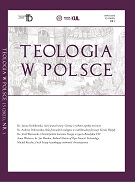Dogmat o Niepokalanym Poczęciu NMP wiązał się bardzo ściśle z wypracowaniem przez teologów takich pojęć jak ustrzeżenie – praeservatio oraz odkupienie zachowawcze – praeredemptio. Wraz ze stopniowym przenikaniem święta Poczęcia Maryi ze Wschodu na Zachód, teologowie podjęli refleksję na temat jego przedmiotu. Zasadniczą kwestią przed jaką stanęła teologia aby właściwie zinterpretować to zagadnienie było nauczanie o powszechności grzechu pierworodnego, a co za tym idzie o powszechnej potrzebie odkupienia. Problem stanowiła także ówczesna antropologia, według której człowiek miał otrzymywać duszę po upływie pewnego czasu od poczęcia.
Summary
December 8, 2009 marks the 155th anniversary of the proclamation of a dogma of the Immaculate Conception of St. Mary. Such an anniversary is an occasion to come back to this difficult issue of theology and recollect the discussions and debates which resulted in Pius IX’s bull Ineffabilis Deus, followed by the proclamation of his dogma. The problem of original sanctity of the Mother of God became an issue of special interest to theologians who study Mariology. Reflection on the sanctity of Mary was the very source of the dogma of the Immaculate Conception. This was closely related to introducing such notions as being preserved from sin – praeservatio and preservative redemption – praeredemptio. Theologians began to study this issue as the feast of St. Mary’s Conception was spreading form East to West. The basic problem that theology faced in order to properly interpret this issue was the teaching about the generality of the original sin, and as a result, the need of general redemption. Another problem at that time was anthropology, according to which man was given a soul only after some time following the conception. John Duns Scot, a Franciscan monk, proposed a solution. His arguments, just as the arguments of his opponents, were based on the special dignity of Christ. His understanding of it, however, was that that taking St. Mary out of the general rule of sin will not deprive Christ of his glory, but multiply it. By „freeing” God’s activity from time frames he maintained that St. Mary in conceiving Christ was saved from sin, and this happened because of the expected merits of her Son’s Passion.
Ostatnia aktualizacja: 27.02.2012, godz. 12:11 - Janusz Lekan































